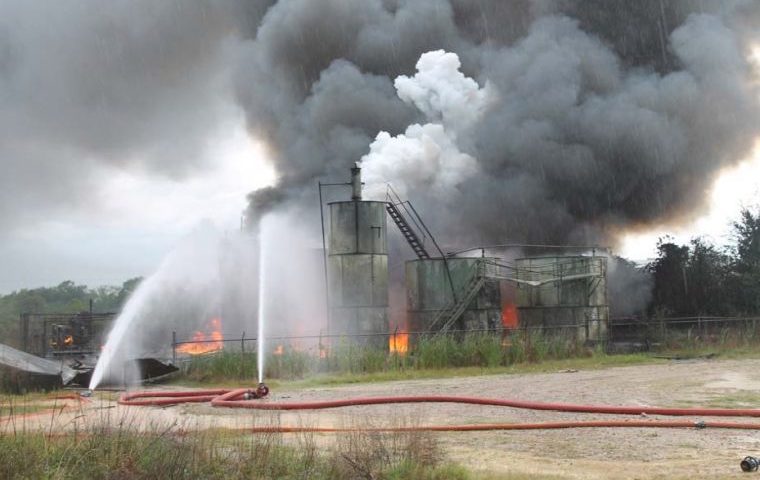- 100% AMERICAN MADE
- Lightning Protection - YOUR time, NOT Downtime

Lightning Protection: Lightning 101 and Beyond
November 14, 2014
Lightning Protection: Vindicated – Lightning is Increasing
November 25, 2014Lightning Protection: TANKS! Grounding Alone is not enough!

Lightning Safety
Lightning Protection Blog
Week 102 | November 20, 2014
The EPA is Gonna Get You!
In my blogs I speak quite frequently about liability with reference to government regulations and fines in line with a lightning strike. While several of you are probably quite aware of fines levied because of pollutants that might be released into the environment, I am not so sure that those of you in the petrochemical and associated sectors are aware of the consequences of not having the appropriate lightning protection on your tanks.
In a specific case which was brought to my attention last year, although it was quite confusing, the tanks were grounded ( steel and fiberglass), but none-the-less it was determined that the “tank battery” did not have adequate lightning protection. So, readers, if you have tanks, and you think you are “Golden”, think again, grounding is not always enough and the EPA will get you in the end.
The case of which I speak is Samson Lone Star in which there were three tanks mentioned. Two of the tanks were steel and one was fiberglass. A copy of the consent order can be viewed at the following link: http://bit.ly/SamsonLoneStar
The document states that lightning struck the tank battery and does not say specifically which tank and just called out the “tank battery” in parenthesis and a whole. However, further on in the document, it is clear that at least one of the steel tanks was hit in addition to another tank. Regardless of which tank was hit, paragraph 17 of the document states that the tanks were grounded but not otherwise protected. The EPA does not make any further comments about compliance with industry standards which is odd because this is usually the focus in the other storage tank cases. The takeaway for me is that if you have an explosion that causes as much damage as is described in paragraphs 12-16, then there is a risk that the EPA is going to fine you and grounded tanks, just might not be enough.
Our associate Tim Hole covers the General Duty Clause of the Clean Air Act in this summary below with additional examples of fines for noncompliance.
As always feel free to contact me with any questions and/or lightning stories at lightningDiva@lecglobal.com
Enjoy,
The LightningDiva@Large
Summary: Lightning Strike Liability Under the General Duty Clause of the Clean Air Act
By Timothy Hole, Legal Research Analyst
Any person who owns or operates a facility that is classified by the EPA as a stationary source[1] should be aware of the potential liability incurred by operating a facility with inadequate lightning protection. The Clean Air Act Amendments of 1990 established Section 112(r)(1), known as the General Duty Clause (GDC). The GDC applies to any stationary source producing, processing, handling, or storing regulated substances[2] or other extremely hazardous substances.[3] The GDC is a broad clause and is a potential source of liability for inadequately protected facilities.[4]
The GDC creates three broad requirements for regulated facilities: (1) Knowing the hazards associated with the chemicals and assessing the impacts of potential releases; (2) designing and maintaining a safe facility; and (3) minimizing the consequences of an accidental release should one occur. Furthermore, the Chemical Accident Prevention Program requires facilities that work with extremely hazardous materials to create a Risk Management Plan (RMP). [5] These facilities must submit an RPM to the EPA every five years. The RPM must include a hazard assessment, a prevention program, and an emergency response program.
Owners and operators are required to be aware of potential hazards to their facilities. One of the main ways that hazards can be identified is through EPA Chemical Safety Alerts and Enforcement Alerts on recognized hazards. When risks are identified by the EPA, the agency will issue an alert. Once an alert is issued, a potential hazard has been identified and operators should consider themselves notified of the potential hazard to their facility. One of the very first alerts of this type warned of the dangers of lightning strike to facilities handling flammable substances.[6] The EPA considers the hazards associated with lightning strikes to such a facility “well established.”[7]
Given that the hazards associated with lightning are so well established, an owner or operator of a facility covered under the GDC has an obligation to design a facility with appropriate lightning protection. To accomplish this, a facility should meet or exceed industry standards for lightning protection. When assessing whether a facility is adequately protected from lightning, the EPA will consider compliance with industry standards such as the National Fire Protection Association 780 and the American Petroleum Institute 2003. Owners and operators should carefully consider these standards when choosing how to protect their facility from lightning.
Enforcement of the GDC is flexible, which allows each regional office of the EPA freedom to implement an enforcement strategy that works best for them. Generally, each regional office will choose from a mix of three major approaches to enforcement. These are: (1) Compliance outreach; (2) technical assistance; and (3) civil and criminal enforcement. Some regional offices, such as EPA Region 6,[8] are more likely than others to pursue civil enforcement as a means of enforcement of the GDC.[9] This can take the form of a fine following an accidental release of a chemical due to a lightning strike. The authority for these fines is granted in The Clean Air Act Section 113(a)(3) and 113(d)(1)(B).[10] The EPA has the authority to issue fines of up to $37,500 per day for each violation.
One of the EPA’s tools for enforcement of the GDC is through regional decisions. The EPA has issued nine regional decisions concerning lightning since 1986. Of these nine decisions, four were in regards to inadequate RMPs, one involved equipment failure due to lightning, and four decisions addressed accidental releases of controlled chemicals. These four decisions are: In the Matter of: Samson Lone Star, LLC, Rusk County, Texas;[11] In the Matter of: Georgia Power Company;[12] In the Matter of: Wagner Oil Company Acadia Parish, Louisiana;[13] and In the Matter of: Pryme Energy, LLC, Houston, Texas.[14]
Samson and Wagner each had a lightning strike that resulted in an explosion at the facility. Pryme had a static discharge from and improperly grounded fiberglass tank that caused an explosion. In all three cases the EPA issued a fine of $30,000. In Georgia Power the EPA issued a much smaller fine when lightning caused the release of 15 gallons of non-PCB mineral oil. In all three cases the owners and operators faced EPA fines on top of damage to their facilities.
It is worth noting that the EPA may pursue criminal charges for violations of the GDC. This is an unlikely occurrence for general violations of the GDC. In one case where the EPA did pursue this option against Jeffrey L. Jackson and Michael Peters, they likely only did so because the pair were also charged with conspiring to cover up their violations of the GDC.
In summary, owners and operators should be aware that they face potential liability under the GDC and RMP if they do not take steps to ensure that their facilities have adequate lightning protection. In each of the above cases, owners and operators faced situations where their facilities suffered thousands of dollars in property damage and then they were issued fines by the EPA. These potential liabilities can be mitigated by ensuring that a facility is adequately protected from lighting.
![]()
[1] 42 U.S.C. §§ 7401-7671Q, as amended by the CAA Amendments of 1990, Pub. L. 101-159, 104 Stat 2399-2712. CAA section 112(r)(2)(c) defines “stationary sources” as: “Any buildings, structures, equipment, installations, or substance emitting stationary activities which belong to the same industrial group, which are located on one or more contiguous properties, which are under the control of the same person (or persons under common control), from which an accidental release may occur.”
[2] Listed substances can be found in 40 C.F.R. § 68.130.
[3] Any chemical listed in 40 CFR part 68 or any other chemicals which could be considered extremely hazardous. While there is no definition for “extremely hazardous”, the Senate report for the 1990 CAA Amendments suggest that the term would include “which may or may not be listed or otherwise identified by any Government agency which may as the result of short-term exposures associated with releases to the air cause death, injury or property damage due to its toxicity, reactivity, flammability, volatility, or corrosivity” (Senate Committee on Environment and Public Works, Clean Air Act Amendments of 1989, S. Rep. No. 228, 101st Cong. 211 (1989) – “Senate Report”)
[4] 29 U.S.C. § 654. Owners and operators must comply with the general duty clause in the same manner and the same extent as employers must comply with the Occupational Safety Health Act administered by OSHA.
[5] Facilities holding more than a threshold quantity of a regulated substance in a process. Threshold quantities vary be chemical and can be found in 40 C.F.R. §68.130.
[6] U.S. EPA, Lightning Hazard to Facilities Handling Flammable Substances (1997) (EPA 550-F-97-002c), available at http://www.epa.gov/osweroe1/docs/chem/lit-flam.pdf (last visited Oct. 28, 2014).
[7]“In the Matter of: Wagner Oil Company Acadia Parish, Louisiana” (EPA Docket No.
CAA-06-2014-3302), January 14, 2014.
[8] EPA Region 6 encompasses TX, NM, OK, AR, and LA.
[9] For an analysis on each of the enforcement methods and how the EPA decides between them, see U.S. EPA, GUIDANCE FOR IMPLEMENTATION OF THE GENERAL DUTY CLAUSE CLEAN AIR ACT SECTION 112(r)(1) (2000) (EPA 550-B00-002).
[10] 42 U.S.C. §§ 7413(a)(3), 7413(d)(1)(B).
[11] EPA Docket No. CAA-06-2013-3343, July 01, 2013.
[12] EPA Docket No. CWA-04-2008-5130(b), July 23, 2008.
[13] EPA Docket No. CAA-06-2014-3302, January 14, 2014.
[14] EPA Docket No. CAA-06-2014-3307, April 14, 2014

